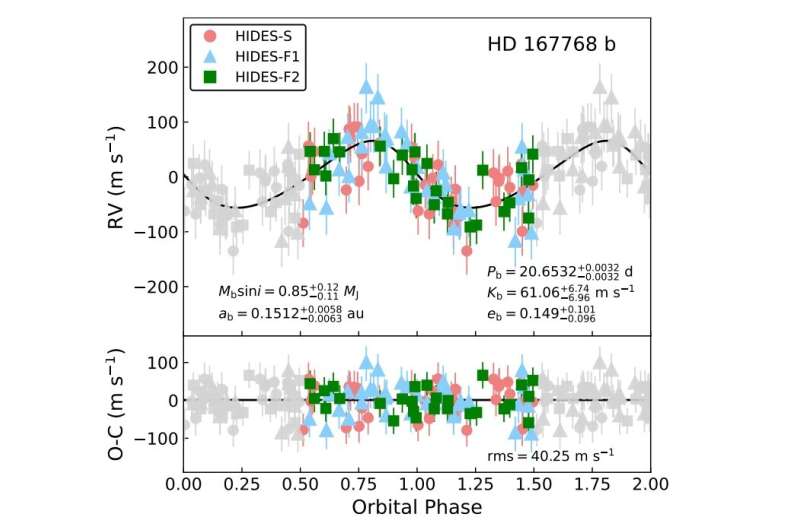Phase folded best-fit orbital solution of HD 167768. Credit: Teng et al., 2022.
Using radial velocity measurements, astronomers from Japan and China have detected a new exoplanet orbiting a G-type giant star. The newfound alien world is similar in mass to Jupiter but much hotter than the solar system's biggest planet. The discovery is reported in a paper published November 12 on the arXiv pre-print server.
The radial velocity (RV) method to detect an exoplanet is based on the detection of variations in the velocity of the central star, due to the changing direction of the gravitational pull from an unseen exoplanet as it orbits the star. Thanks to this technique, more than 600 exoplanets have been detected so far.
Now, a group of astronomers led by Huan-Yu Teng of the Tokyo Institute of Technology in Tokyo, Japan, reports the finding of a new giant planet as a result of RV measurements using the HIgh Dispersion Echelle Spectrograph (HIDES) at Okayama Astrophysical Observatory (OAO) in Japan. The planet orbits a deeply evolved solar-mass G-type giant star known as HD 167768, located some 353 light years away.
"For HD 167768 RVs, we could find a strong signal at 20 d, indicating a regular variation in the time series," the researchers explain.
The newly detected exoplanet, designated HD 167768 b, is estimated to have a mass of at least 0.85 Jupiter masses. It orbits its host every 20.65 days, at a distance of approximately 0.15 AU. The equilibrium temperature of this planet was calculated to be 1,874 K.
Due to its parameters, the authors of the paper have classified HD 167768 b as a "warm Jupiter." The planet has turned out to have one of the shortest orbital periods among those ever found around deeply evolved stars using radial velocity methods.
The host star HD 167768, estimated to be 5.3 billion years old, is of spectral type G8 III, has a mass of around 1.08 solar masses, and is nearly 10 times larger than the sun. It has an effective temperature of 4,851 K, and its metallicity is at a level of -0.75.
Given that HD 167768 is expected to ascend the red giant branch, the astronomers predict that its planet will be swallowed in a relatively short time in astronomical terms. By analyzing the orbital evolution, they estimate that HD 167768 b will be engulfed by the expanding star within about 150 million years.
The researchers also assume that at least two other planets may be present in the HD 167768 system, still undetected. This assumption is based on the two additional regular variations identified in the RV measurements.
"In the periodogram of the residuals, there are two additional signals at 41 d and 95 d with FAP [false alarm probability] slightly lower than 0.1 percent, suggesting possible extra companions in the system," the scientists note.
More information: Huan-Yu Teng et al, A Close-in Planet Orbiting Giant Star HD 167768, arXiv (2022). DOI: 10.48550/arxiv.2211.06576
Journal information: arXiv
© 2022 Science X Network
























